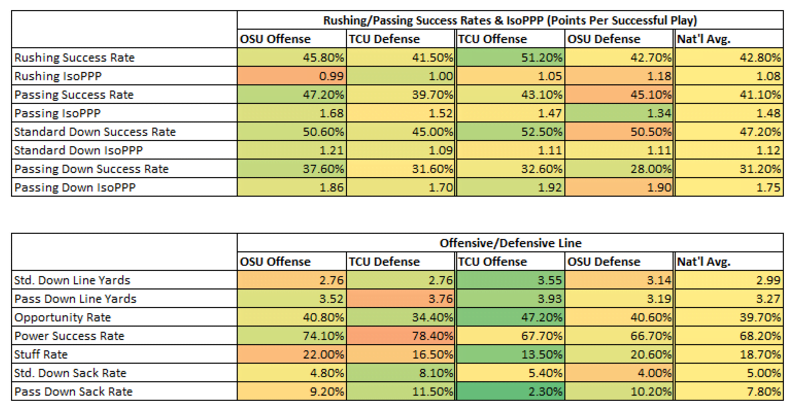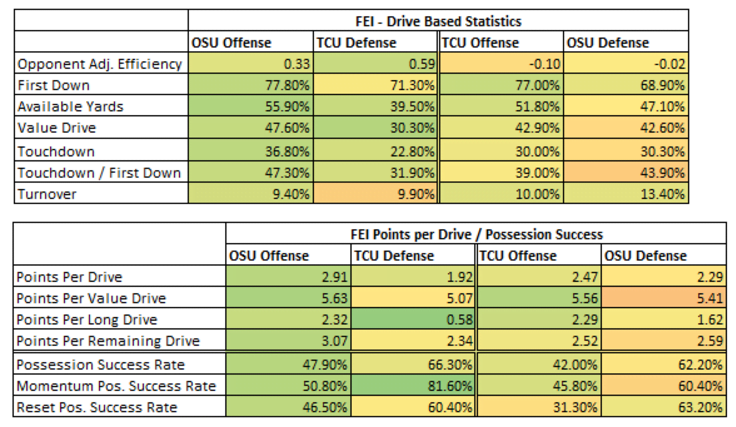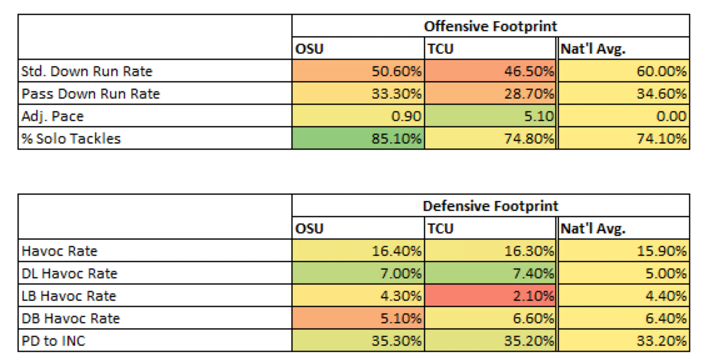Football
OSU-TCU Advanced Stats: Field Position Is Paramount
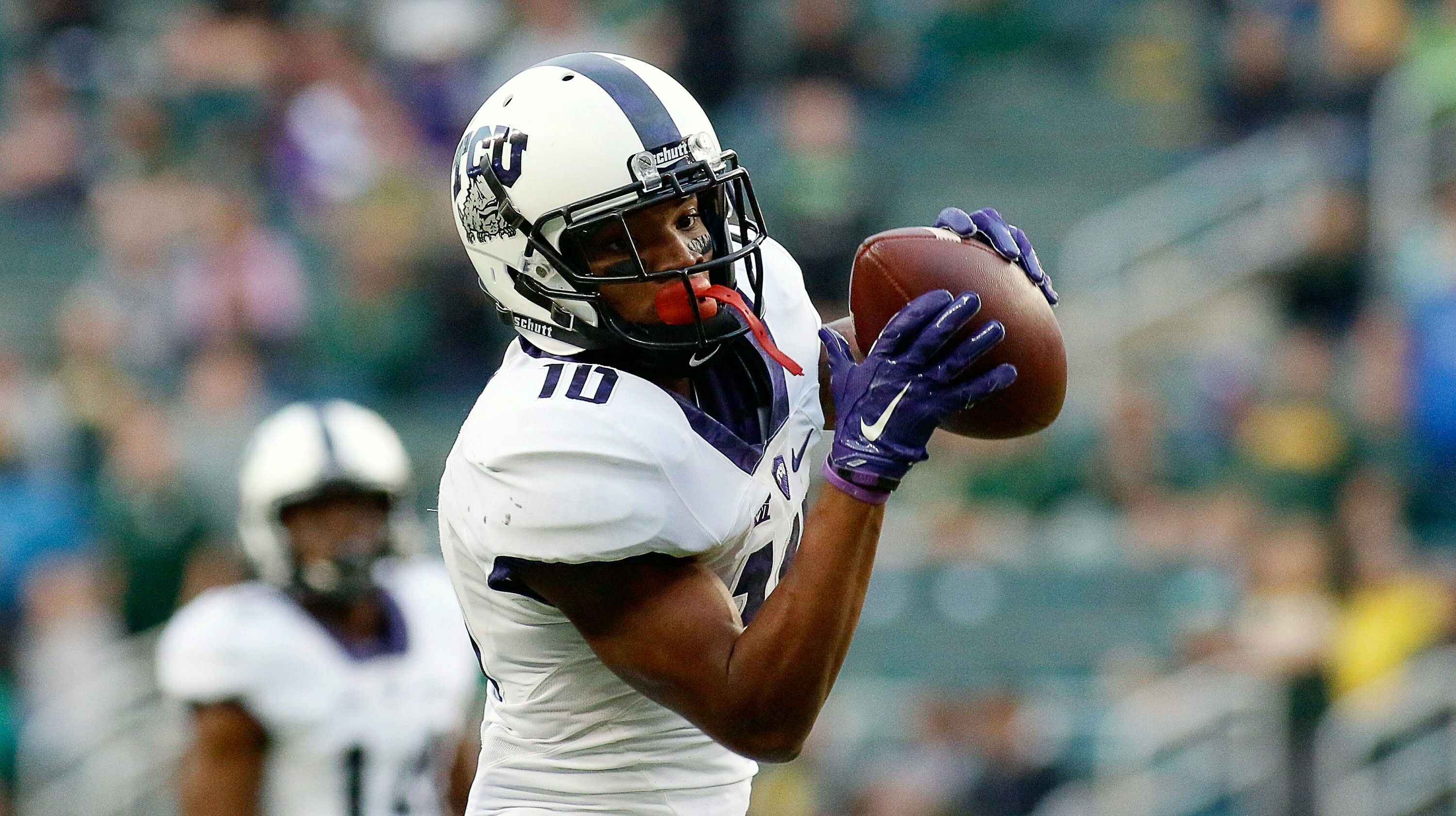
Here is your weekly deep dive into the numbers from @BradF79. As always, it’s awesome.
As we did last week, before we look at TCU, let’s take a quick look back at the Texas Tech game and what I identified as the keys to the game…
• Can the OSU offense keep from beating itself with turnovers and penalties?
OSU did a decent job of not beating itself, though you’d certainly like to score on the first three possessions instead of only the first two and you really need to prevent that McCleskey fumble that turned into 7 points for TTU. In the second half, the 3.4 points per drive (not counting last ‘clock killing’ possession) was almost not enough…
• Can OSU defense get off the field on 3rd down and limit the success of TTU on passing downs?
OSU allowed a 47 percent 3rd down conversion rate which is not that good (national average 40 percent; OSU season average 41.3 percent). Of the nine 3rd downs not converted, TTU was able to convert on 4th down on three of them (100 percent success rate, one was a fake punt).
That essentially puts it at 58 percent conversion rate if you count the two standard 4th down conversions. It’s worth noting that TTU averaged 55 percent on 3rd down and 42 percent on 4th down prior to this game.
• Can OSU special teams find a way to impact the game (blocked FG/P or perhaps a long return)?
TTU converted a fake punt and an onside kick successfully, but also missed the XP that could have sent the game into OT. Regardless, I believe OSU lost the battle on special teams.
• Can the OSU control time of possession with the run game keep the TTU offense on the sideline?
OSU did not control the TOP and the run game was not good in the first half (52 yards on 16 carries) before finally turning it on in the second. I saw lots of hand wringing over the TTU run game and the OSU defense. Despite what it may have looked like, OSU held TTU to a 40% rushing success rate, their lowest of the season except for their ASU game (30%).
Turnovers.
How big was the fumble recovery by Vincent Taylor after that onside kick? Without it, OSU may not have escaped with a W. The actual stats will say the turnover battle was even at 1-1 but TTU stole possessions with the onside kick and the fake punt.
In summary, much like the KSU game, it seems like a miracle OSU escaped with a win. As much as people want to talk about the missed XP deciding the game, even if he makes it, or they successfully complete a 2 point conversion, OSU had over 1:30 to score with 2 timeouts. My money would be on the offense completing the comeback, though I’m certainly glad it didn’t come to that.
TCU
Moving on to TCU… TCU presents a nice challenge for OSU. TCU is as healthy as they’ve been this season, coming off a bye week and a game where they thumped Baylor 62-22 and ran for over 400 yards (not a typo).
Their defense will be the best OSU has faced since WVU, a game where OSU only put up 358 yards (85 on the ground) and most likely only won because WVU turned it over 3 times. That said, their best win (excluding Baylor) is over Iowa State. Let’s jump right into the numbers… (keep in mind you can access the glossary here).
Five Factors
Let’s start with the OSU offense, they continue to take advantage of positive field position which is a key to their success so far this season. They are efficient and explosive, producing enough big plays each game to put pressure on the opposing team.
The TCU defense is, by these numbers, fairly average. They’ve done a decent job of limiting the success rate and explosiveness of the opposing teams, however the OSU offense has an advantage here.
The TCU offense hasn’t been that explosive this season, but their efficiency and field position are near equivalent to OSU. Their field position numbers are mostly the result of a great return game.
They are only average at finishing drives and are -2 in the turnover battle. TCU will have an advantage if the OSU defense can’t get stops inside the 40 (turn TDs into FGs) and TCU can limit their turnovers.
Turnovers will be incredibly important. Hill has thrown 10 interceptions so far this year and fumbled 3 times. OSU has to hope that trend continues this week, but TCU did not turn the ball over once vs Baylor.
Success Rates
OSU’s offensive rushing success rate is climbing, it’s now nearly 46 percent (good for 40th in FBS). While they haven’t been that explosive when rushing (that 0.99 value in Rushing IsoPPP is 99th in FBS) the fact they are generating success speaks to how the offense is improving.
OSU is good to great across the board with a few exceptions, sack rate on passing downs and stuff rate. Stuff rate is how often they are stopped at or behind the LOS on rushing plays, 22% is nearly last in FBS.
In addition, Mason is getting sacked on 9% of all passing down drop backs which especially concerning going up against a TCU team that gets sacks 11.5 percent of the time on passing downs.
There are some silver linings here when going against this TCU defense. First of all, they are allowing a first down or TD on 3rd/4th and 2 or less (power success rate) on nearly 80 percent of opponent attempts and their stuff rate is only 16.5 percent.
These numbers point to a weakness in stopping the run, especially on passing downs. You still have to watch out for their pass rush when you decide to throw the ball however, as their sack rates are top 15 in FBS.
When TCU has the ball, I expect them to pound the ball with the run. Their 51 percent success rate when rushing is is top 10 in FBS and they are rarely getting stopped at or behind the line (stuff rate).
They are great on standard downs as well (1st down, 2nd and 7 or less, 3rd/4th and 4 or less), top 15 in FBS. These numbers help keep the number of times they face 2nd/3rd long (passing downs) to a minimum. Looking for a weakness in the run game, you have to look toward their power success rate which is about average at 67 percent.
OSU’s defense has been pretty terrible the past few weeks regardless of what you’ve read on this blog or elsewhere. The numbers are also starting to show it as well.
They can’t get teams to passing downs because they are struggling on standard downs, when they do finally get teams into passing downs, their success rate is fairly good and they have been able to generate some sacks as well (10.2% sack rate on passing downs, 28% opponent success rate on passing downs).
Moving on to drive-based stats we see the OSU offense is getting better and better. Excluding drives starting inside their own 20, OSU’s PPD number is above 3 at 3.07.
Of drives longer than 80 yards, OSU is still a very respectable 2.32 PPD. However, this TCU defense on long drives is absurd. TCU gives up less just over half a point (.58) on drives over 80 yards.
This is why field position is so important. They are also extremely good at getting stops after their offense scores (81.6 percent momentum possession success rate). If you are looking for good news, the TCU defense turnover rate, which is 9.9 percent is not very good and their giving up a fairly average 2.34 point per drive on standard drives of less than 80 yards.
That said, this TCU defense on a drive based view is very good, top 20 in FBS.
The TCU offense numbers look a little ‘off’ to me and I actually had to go back and verify them. The opponent adjusted efficiency of this offense (-.10) is 76th in FBS, however when you look at their individual numbers, they look much better than that.
They are scoring points just as good as OSU on long drives (2.29 PPD) but only 2.52 on standard drives which is the reason for their poor adjusted number (based on the defenses they’ve played).
If you remove the Baylor game, their offense has been extremely bad the past few games: 24 points vs TTU, 10 points vs WVU, 24 points vs KU. Whether Baylor was a shift in focus or an anomaly we will soon find out.
Both the TCU offense and defense seem susceptible to the ‘snowball’ effect when looking at their reset possession success rates. A reset possession is a possession success after a possession loss.
For example, scoring after your defense gives up a score. Or the defense getting a stop after the offense punts or turns the ball over. If OSU can jump out on them, it could open a path to victory that isn’t as stressful as those we’ve seen recently.
Opponent-Adjusted Success
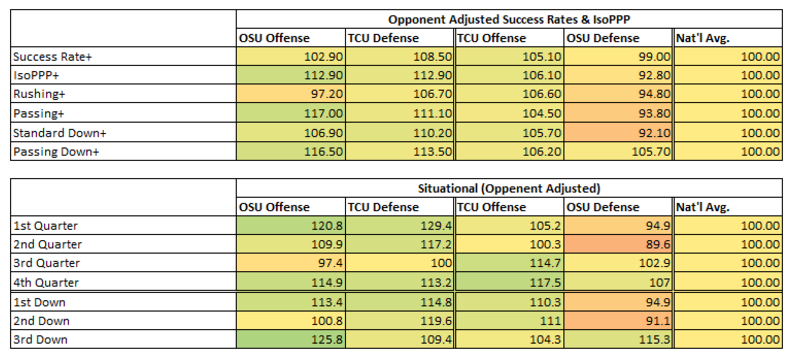
One thing I don’t think I’ve explained on these S&P opponent-adjusted numbers is what the values mean. Essentially, 100 is average, anything below 100 is below average and anything above 100 is better than average. The further from 100 you get, the more bad or good you are at that particular stat.
Again, we see an OSU offense that is very good. Their opponent-adjusted rushing number is improving and as is their 3rd quarter and 2nd down success (something I’ve harped on in past installments).
I have no doubt these improvements are due to the improvements in the running game. OSU’s 3rd down offense is top 15 in FBS and their explosiveness, passing, and passing down success are all essentially top 30.
Looking at the TCU defense we see some great numbers, especially vs what we saw on the unadjusted success rates. This is a defense that held TTU to 27 points (in 2OT) and Baylor to 22 in Waco.
If you want to compare to how we did vs those teams, feel free, I’ll wait. This is a great matchup of a top No. 15 opponent adjusted offense (OSU) vs a really good defense.
TCU’s offensive numbers are good, improving into the 4th quarter even. They have some struggles on 3rd down which will hopefully allow OSU a chance get off the field.
The OSU defense has somehow found a way to be better than average in the second half of games and peak on 3rd down (which seems absurd given what I’ve witnessed the past two games).
As has been said, if TCU is successful on standard downs (especially to the extent KSU and TTU were), it’s going to be a long game for the defense and the offense is going to have to play at it’s peak in a shootout.
Offensive/Defensive Footprints
The OSU offense seemingly is running at an average pace this year despite their ‘turbo’ package that’s used at times. They are running the ball around 50% of the time on standard downs, 33% on passing downs.
When you look at TCU defensive footprint, you see a havoc rate (sacks, tackles for loss, passes defended, interceptions) that’s nearly identical to OSU, but recall their defensive numbers above are much, much better. They clearly have a weakness at LB which OSU should be able to exploit.
Despite that low havoc rate for their LBs, Travin Howard leads the team in tackles (13.4 percent of all team tackles) and safety Dezel Johnson has 9 TFL. On the DL, Aaron Curry, Josh Carraway, and Mat Boesen all could present problems for the OSU offensive line.
The TCU offense is running the ball less than OSU (or has up to this point) but that could change following their 400+ yard outing vs Baylor. They do like to go fast on offense and have a much faster pace than OSU.
The OSU defensive weakness is in its secondary despite Jordan Sterns leading the team in tackles and being tied for the most INTs (3, Ramon Richards). On the DL, Vincent Taylor and Tralund Weber lead in sacks and TFL.
Special Teams

OSU continues to get value from their special teams, specifically, Grogan, Ammendola, and Sinor. They’ve still not been able to generate any sort of decent (or consistent) return however.
Ammendola will need to have a good day as TCU has the best return kick return team OSU has seen since KSU (and we know how that went). Turpin is averaging 32 yards per return and has one punt return TD so far this year.
TCU is not getting a lot of value from their kicker and their punt success hasn’t been great. Their punter is only generating fair catch or inside 20 stop on 65% of his punts (compared to 83% for Sinor) and their kicker is only getting a touchback on just over 41% of kickoffs.
The chance for a return should be there Saturday, but can OSU make anything happen.
Conclusion
This is the best defense OSU has faced since West Virginia. If the offense plays within itself, does not get impatient and the OL can open up running lanes at times and keep Mason off his back they will get their points.
The offense OSU will face is definitely a step down from TTU, but maybe not as much as you think. Their 62 point output vs Baylor has to have them extremely confident in their ability to score on the OSU defense that hasn’t been good.
Keys to the game
• Defense must be better on standard downs and put TCU into passing downs (then find a way to get off the field on those passing downs).
• Punt and kick coverages must be tight, cannot let Turpin (or anyone for that matter) affect the game with a long return.
• Force Hill to turn the ball over. He has 14 TDs to 10 INTs and has fumbled 3 times. Get after him.
• Make a play in special teams. No returner has done anything impressive this year. It’s time for them to make an impact.

-

 Hoops4 days ago
Hoops4 days agoFIU Transfer Arturo Dean Commits to Oklahoma State
-

 Football5 days ago
Football5 days agoThe Top 5 Quotes from Mike Gundy’s Final Spring Practice News Conference
-
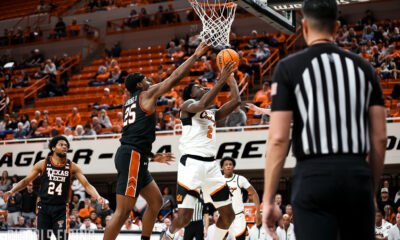
 Hoops3 days ago
Hoops3 days agoTexas Tech Transfer Robert Jennings Commits to Oklahoma State
-
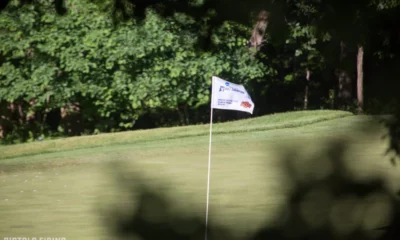
 Golf4 days ago
Golf4 days agoOSU Freshman Preston Stout Sinks Long Putt to Earn Share of Big 12 Title


